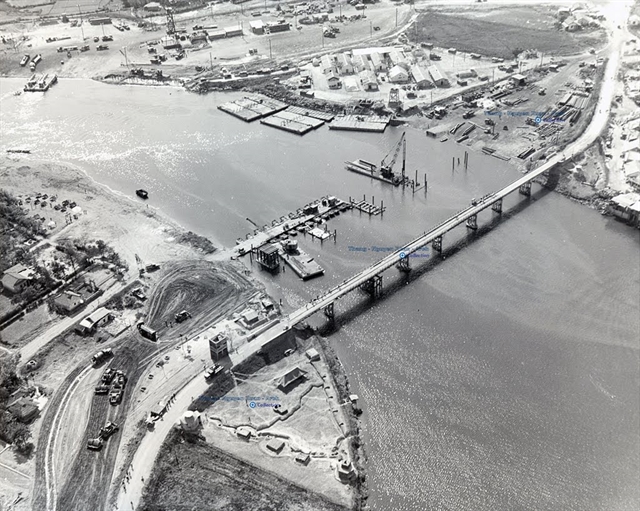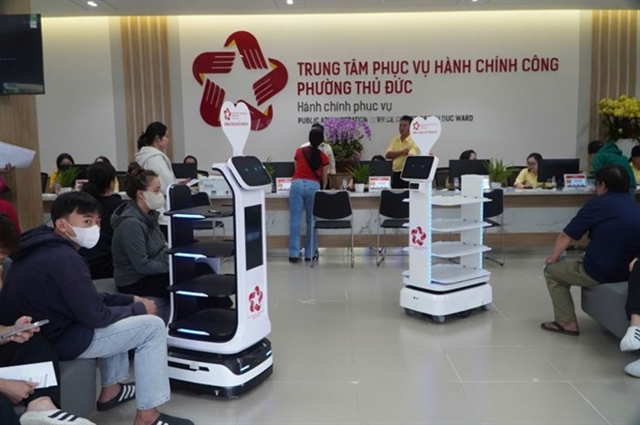 In the Spotlight
In the Spotlight

The Ministry of Transport has submitted to the Government an investment plan for the ongoing North-South Expressway from Hà Nội to HCM City. Some experts are not keen.
 |
| Sections of North-South Expressway. — Illustration by Đoàn Tùng |
Hồng Minh
HÀ NỘI — The time it takes Nguyễn Phương Hoài, a resident of Hà Nội’s Nam Từ Liêm District, to get to her hometown in Ninh Bình Province has been reduced by half in the last four years since the opening of the Cầu Giẽ-Ninh Bình Expressway.
In the past, the 102km-section of National Highway 1 to Ninh Bình used to take her around three hours at a speed of 80kmph. Now she takes the Pháp Vân-Cầu Giẽ Expressway from Hà Nội to Hà Nam Province, where she connects to the Cầu Giẽ-Ninh Bình Expressway, where the speed limit is 100-120kmph. The route takes her less than one hour and a-half.
“I really enjoy the expressway as I can drive fast and don’t have to share the road with motorbikes and bicycles, which makes it much safer than the old highway,” she said.
“The only problem is now I am charged VNĐ110,000 (about US$4.90) one way, a bit more than on the upgraded National Highway 1,” she added.
The Pháp Vân-Cầu Giẽ and Cầu Giẽ-Ninh Bình expressways that Hoài uses are completed sections of the North-South Expressway, a master expressway running parallel to National Highway 1, from Hà Nội to the Cửu Long (Mekong) Delta city of Cần Thơ.
Four sections of the four-lane expressway, 171 km long, are already operational - Pháp Vân-Cầu Giẽ, Cầu Giẽ-Ninh Bình in the north, and HCM City-Trung Lương (Tiền Giang Province) and Dầu Giây (Đồng Nai Province)-Long Thành-HCM City in the south.
Almost 300 other kilometres are under construction with completion planned for 2020, including Đà Nẵng-Quảng Ngãi, Bến Lức (Long An Province)-Long Thành and Trung Lương-Mỹ Thuận-Cần Thơ.
The other sections, totaling more than 1,300km, are awaiting investments before construction starts in 2020.
The Ministry of Transport recently submitted a plan to the Government suggesting a total investment of about VNĐ230 trillion ($10.2 billion) for the construction of more than 1,620km from 2017 to 2022, with VNĐ93.5 trillion, 40.7 per cent of the total, to be funded by the State. The rest would be mobilised from organisations and individuals.
Deputy Minister of Transport Nguyễn Nhật said the proposals are based on a master plan approved by the Prime Minister for 6,114km of expressways throughout the country by 2030. Of those, some 2,000-2,500km of expressways are planned to be completed by 2020.
"In the past years, the MoT has completed 746km out of the total 6,114 km, but this is still a limited number,” Nhật said.
“Therefore, the MoT proposed the investment scheme, which focuses on the eastern route with a length of over 1,300km from Hà Nội to HCM City to ensure the transport needs of the north-south route and the development of key economic zones of the coastal region it runs through,” Nhật added.
He said the road sections where volume is forecast to reach 30,000-35,000 vehicles by 2030 would span four lanes at least 22m wide. Other sections with less transport demand would have four lanes 17m wide.
To build or not to build
While many drivers like Hoài welcome the completion of such a north-south expressway as soon as possible, some experts have raised concerns about the necessity to invest in the road at this time.
Transport expert Nguyễn Xuân Thủy said that the North-South Expressway is a waste of money since there are already four routes running parallel from the north to the south.
“First of all, there’s the sea route – a dream route for many countries due to its convenience,” Thủy said, adding that sea transport was also cheap and productive compared to other means.
“Secondly, the north-south rail route, though it is degraded, is still transporting some 15 million tonnes of goods,” he said.
“The third and the fourth are National Highway 1 and the Hồ Chí Minh Highway, which are all in good condition,” he said.
Thủy added that people and enterprises will choose the route with the most reasonable cost. He predicted that once completed, the total tolls for the North-South Expressway would be millions of đồng, especially high for transport enterprises, so people would take National Highway 1 and transport goods by rail instead.
“I think the North-South Expressway would be less attractive for transport enterprises,” he said, adding his concern that the expressway would only serve the well-to-do people.
He said the investment should go instead to upgrade existing highways, seaways and railways.
Chairman of the Hà Nội Transport Association Bùi Danh Liên agrees, saying the project is not urgent given that the existing routes basically meet the demand of transporting people and goods.
He said the MoT should focus on the railway as the country’s main transportation artery.
“Due to Việt Nam’s length, I think it’s not right to ignore the need to upgrade the railroads,” Liên said.
“What needs to be done now is to upgrade the north-south railway line, extend its width from 1m to 1.435m gauge so that trains can increase speed. At the same time, National Highway 1 should be upgraded,” he said.
Phạm Sanh, a lecturer at HCM City University of Transport, said the expressway is necessary but its deadline should be extended.
“The deadline can be 2025 or further, instead of 2020 as planned, and in the meantime, we can focus on key sections to ease the loads on sections with a high transport flow and recurring traffic accidents,” he said.
“Priority should be given to the Cửu Long Delta, especially the Trung Lương-Mỹ Thuận-Cần Thơ,” he said.
Defending the ministry’s plan, Director General of the Transport Engineering Design Company, Phạm Hữu Sơn, said the MoT’s proposed North-South Expressway would serve up to 45 per cent of the population of 20 cities and provinces it runs through.
“The expressway will also provide access to 75 per cent of major sea ports, as well as key economic regions of the coastal area, so it will be a great transport help,” he said.
“The expressway will not only promote economic development of the 20 cities and provinces, but of the whole country. In addition, some 430km of site clearance coincides with the Hồ Chí Minh Highway so it can help save cost,” he added.
Deputy Minister Nhật echoed the opinion, saying that investment in the expressway is the best choice as railway and seaway transport cannot reach all economic zones.
“Expressways also have more advantages in term of collecting tolls than highways. For example, National Highway 1 is collecting fees based on toll stations so vehicles have to pay the same fee no matter how long or short their route, while expressways collect tolls based on the actual kilometres travelled, so it’s fairer,” Nhật said.
“Statistics from the MoT indicate that National Highway 1 will face traffic congestion by 2020 and so building an expressway just for cars is very necessary,” he said.
He added that a high-speed railway from Hà Nội to HCM City would cost $55 billion, much more than construction of the expressway.
Pressure on public debts
Another concern is whether funding 40.7 per cent of the expressway from Hà Nội to HCM City would pressure the public debt.
The chairman of Hà Nội Transport Association Liên said that given that public debt had exceeded the threshold limit, the construction of the North-South Expressway is worth careful consideration.
A report on the country’s debts and obligations for 2016-2020 released in late October by the National Assembly’s Finance and Budget Committee showed that the national debt had reached more than VNĐ2.6 quadrillion ($116 billion) as of the end of 2015, equivalent to 62.2 per cent of the GDP.
“If such an investment burdens the financial planning, I think we should not carry out the project,” Liên said.
Economist Nguyễn Minh Phong from the Hà Nội Institute for Social Economic Development Studies said that the VNĐ93 trillion State funding would further inflate public debt.
“Most transport projects are a financial risk due to the high investment and lack of transparency in total investment and contracts,” Phong said, adding that such a huge investment would require mobilisation from sources both at home and abroad.
Deputy Minister Nhật, meanwhile, is certain the 40.7 per cent of investment covered by the State budget is safe as the ministry had carefully calculated it in the context of high public debt ceiling.
"The proposed ratio of support from the the State budget is lower than previous projects. On the other hand, from lessons learned from the expansion of National Highway 1, once we progress, we will be able to reduce the reserve capital,” he said.
High investment or public debt may not be the top concern of individual drivers like Hà Nội resident Hoài, who worries more about how much she would pay once the expressway is completed.
“The two other routes of National Highway 1 and Hồ Chí Minh Highway have started to collect tolls. Once the North-South Expressway is put into operation, the investor will also collect fees. I hope the opening of the new expressway will not push the other routes to increase their tolls, as well,” Hoài said.
“I hope the fee is calculated reasonably so that it does not cause misery to end users like me and transport enterprises,” she said. — VNS




.jpg)